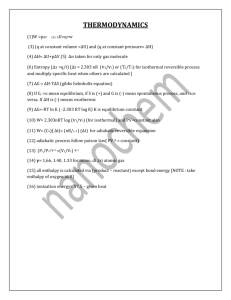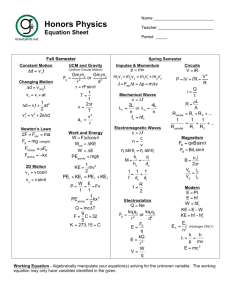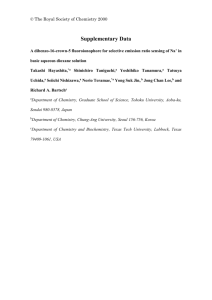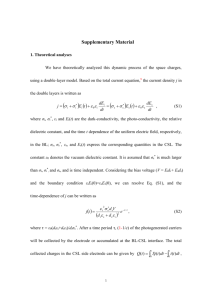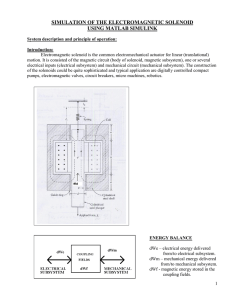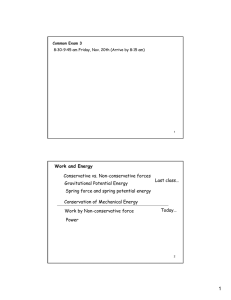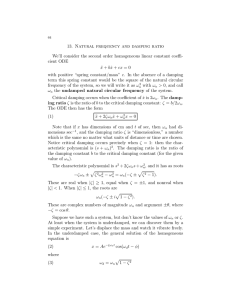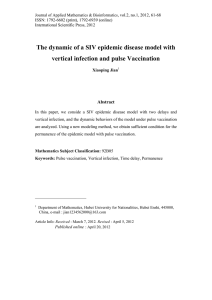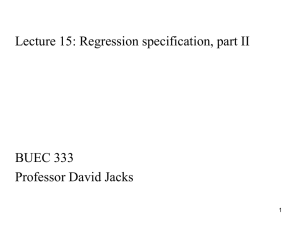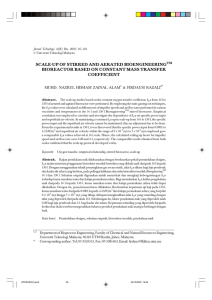Document 13046222
advertisement
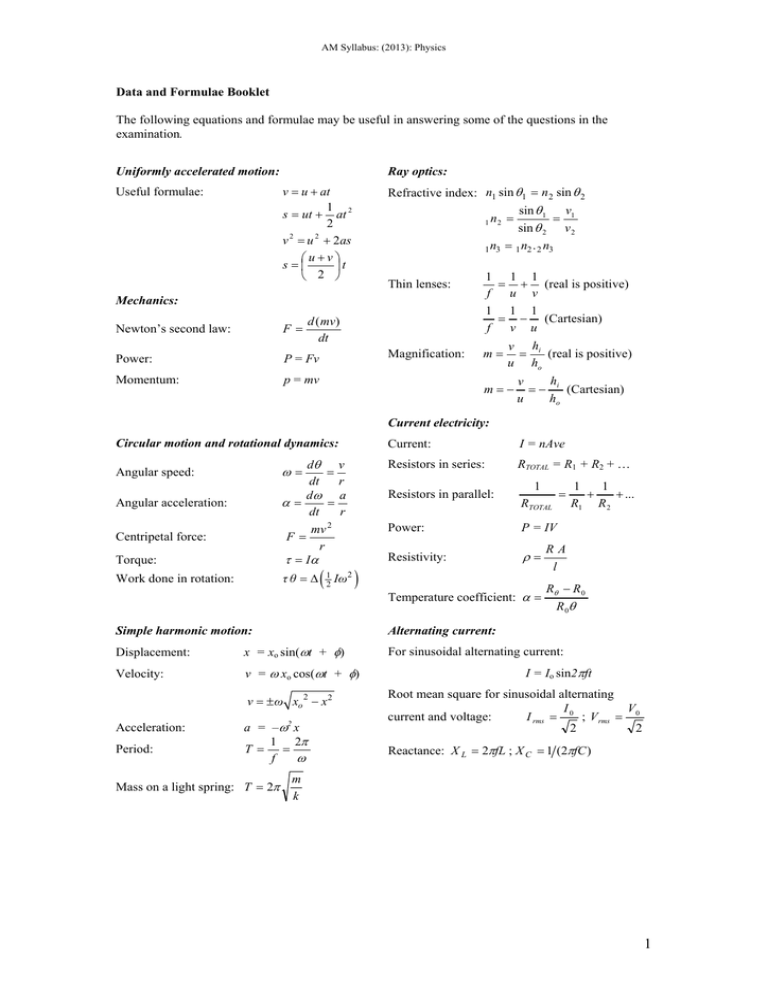
AM Syllabus: (2013): Physics Data and Formulae Booklet The following equations and formulae may be useful in answering some of the questions in the examination. Uniformly accelerated motion: Ray optics: Refractive index: n1 sin θ1 = n 2 sin θ 2 v = u + at 1 s = ut + at 2 2 v 2 = u 2 + 2as ⎛u+v⎞ s=⎜ ⎟t ⎝ 2 ⎠ Useful formulae: 1 1 n3 d (mv) dt F= Power: P = Fv Momentum: p = mv Magnification: sin θ 1 v1 = sin θ 2 v 2 = 1 n2 . 2 n3 1 1 1 = + (real is positive) f u v 1 1 1 = − (Cartesian) f v u Thin lenses: Mechanics: Newton’s second law: n2 = m= v hi = (real is positive) u ho m=− h v = − i (Cartesian) u ho Current electricity: Circular motion and rotational dynamics: Torque: dθ = dt dω α= = dt mv 2 F= r τ = Iα Work done in rotation: τθ = Δ ω= Angular speed: Angular acceleration: Centripetal force: ( 1 2 v r a r Iω2 ) x = xo sin(ωt + φ) Velocity: v = ω xo cos(ωt + φ) v = ± ω xo 2 − x 2 a = –ω2 x 1 2π T = = f ω Mass on a light spring: T = 2π Resistors in series: RTOTAL = R1 + R2 + … 1 RTOTAL Power: P = IV Resistivity: ρ= Temperature coefficient: α = = 1 1 + + ... R1 R 2 RA l Rθ − R 0 R 0θ Alternating current: Displacement: Period: I = nAve Resistors in parallel: Simple harmonic motion: Acceleration: Current: For sinusoidal alternating current: I = Io sin2πft Root mean square for sinusoidal alternating I V I rms = 0 ; V rms = 0 current and voltage: 2 2 Reactance: X L = 2πfL ; X C = 1 (2πfC ) m k 1 AM Syllabus: (2013): Physics Capacitance: Stationary waves: v= T Speed of waves on strings: Capacitance of parallel plates: C = μ Capacitors in parallel: Wave motion: s= Two slit interference: Capacitors in series: λD Diffraction grating: d d sinθ = nλ Single slit diffraction: θ= λ a Charging: Diffraction of circular aperture: sin θ ≈ θ = 1.22 λ a Uniform field: Force between point charges: F dV =− dr +q F V E= = +q d E= F= Q1Q 2 4πε 0 r 2 Electric field strength of a point charge: Q E= 4πε 0 r 2 Force between point masses: Electric potential: Gravitational potential: Work: Discharging: d C = C1 + C2 +… 1 1 1 = + + ... C C1 C 2 1 W = CV 2 2 −t ⎛ ⎞ Q = Q0 ⎜ 1 − e RC ⎟ ⎝ ⎠ Q = Q0 e −t RC Inductance: Fields: Electric field strength: Energy stored: ε 0ε r A M 1M 2 r2 Q V= 4πε 0 r GM VG = − r F =G W = QV Mutual inductance: Self inductance: Energy stored: E dI dt E L=− dI dt 1 2 W = LI 2 M =− Electromagnetism: Force on wire: F = BIl Torque on a rectangular coil: τ = BANI Force on moving charge: F = BQv Magnetic flux: Φ = BA Field inside a solenoid: B = μ0 μr nI Field near a long straight wire: B = μ0 Induced emf: I 2π r E = −N dΦ dt Emf induced in a moving conductor: E = Blv Simple alternator emf: V = V0 sin( ωt + φ ) Hall voltage: VH = BI nQt 2 AM Syllabus: (2013): Physics Temperature: Materials: Temperature (K): T = 273.16 Celsius scale: P K Ptr F = kΔx F σ = A Δl ε= l σ Y= ε Hooke's law: θ (°C) = T (K) – 273.15 K Stress: Strain: Young's modulus: E = 12 k ( Δl ) Energy stored in a stretched wire: First and second laws of thermodynamics: First law of thermodynamics: ΔU = ΔQ + ΔW Ideal heat engine: η = 1− Gases: Ideal gas equation: Kinetic theory of an ideal gas: PV = Boltzmann's constant: k = 1 Nm < c 2 > 3 R NA Principal molar heat capacities of an ideal gas: γ = Adiabatic process: Heat transfer: Thermal conduction: Tc Th PV = nRT CP ; CP – CV = R CV 2 dQ dθ = −kA dt dx Quantum phenomena: Quantum energy: E = hf Mass-energy E = mc2 Energy levels: ⎛1 ⎞ hf = Φ + ⎜ mv2 ⎟ ⎝2 ⎠ max hf = E2− E1 De Broglie wavelength: λ= Photoelectric effect: h mv Radioactivity: Decay rate: PVγ = Constant dN = − λN ; A = λ N dt N = No e−λt Half-life: T1 = 2 ln 2 λ Absorption law for gamma radiation: I = Io e−μd 3 AM Syllabus: (2013): Physics Mathematical Formulae: Surface area of a sphere: S = 4π r 2 Volume of a sphere: V= Surface area of a cylinder: S = 2π rh + 2π r 2 Volume of a cylinder: V = π r 2h Logarithms: ln x n = n ln x 4 3 πr 3 ( ) ( ) ln e kx = kx Equation of a straight line: y = mx + c Relationship between cosine and sine: sin ( 90° − θ ) = cos θ Small angles: sin θ ≈ tan θ ≈ θ (in radians) cos θ ≈ 1 The following constants may be useful in answering some of the questions in the examination. Acceleration of free fall on and near the Earth’s surface g = 9.81 m s−2 Gravitational field strength on and near the Earth’s surface g = 9.81 N kg−1 Boltzmann constant k = 1.38 × 10−23 J K−1 Molar gas constant R = 8.31 J K−1 mol−1 Avogadro’s constant NA = 6.02 × 1023 mol−1 Coulomb’s law constant k = 1/(4πεo) = 8.99 × 109 N m2 C−2 Charge of an electron e = −1.60 × 10−19 C Mass of an electron me = 9.11 × 10−31 kg Electronvolt 1 eV = 1.60 × 10−19 J Gravitational constant G = 6.67 × 10−11 N m2 kg−2 Permittivity of free space εo = 8.85 × 10−12 F m−1 Permeability of free space μo = 4π × 10−7 H m−1 Planck constant h = 6.63 × 10−34 J s Speed of light in a vacuum c = 3.00 × 108 m s−1 Unified atomic mass unit u = 1.66 × 10−27 kg 4
